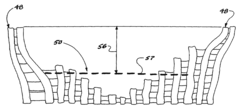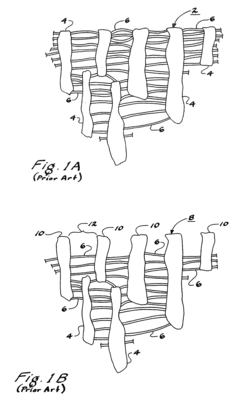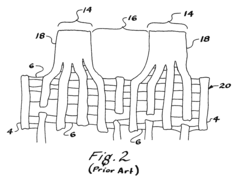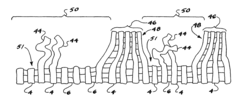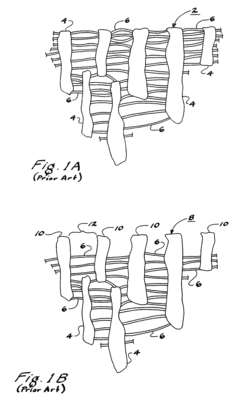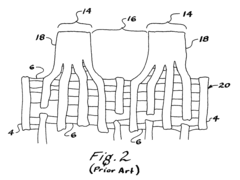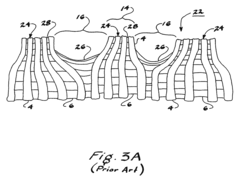How to Use PTFE for Enhanced Surface Protection?
JUN 27, 20259 MIN READ
Generate Your Research Report Instantly with AI Agent
Patsnap Eureka helps you evaluate technical feasibility & market potential.
PTFE Surface Protection Background and Objectives
Polytetrafluoroethylene (PTFE), commonly known as Teflon, has been a revolutionary material in surface protection since its accidental discovery by Roy Plunkett in 1938. This synthetic fluoropolymer has gained widespread recognition for its exceptional non-stick and hydrophobic properties, making it an ideal candidate for various surface protection applications.
The evolution of PTFE technology has been marked by continuous improvements in its formulation and application methods. Initially used primarily in cookware, PTFE's potential for surface protection has expanded to encompass a wide range of industries, including automotive, aerospace, electronics, and industrial manufacturing. This expansion has been driven by the growing demand for materials that can withstand harsh environments while maintaining their protective properties.
In recent years, the focus of PTFE research and development has shifted towards enhancing its durability, adhesion, and overall performance in surface protection. Scientists and engineers have been exploring ways to modify PTFE's molecular structure and incorporate it into composite materials to overcome some of its inherent limitations, such as poor wear resistance and difficulty in bonding to certain substrates.
The primary objective of using PTFE for enhanced surface protection is to create coatings and treatments that offer superior resistance to chemicals, extreme temperatures, and mechanical wear. Researchers aim to develop PTFE-based solutions that can be easily applied to various surfaces, adhere strongly, and provide long-lasting protection without compromising the material's unique properties.
Another key goal is to expand the application range of PTFE in surface protection. This includes developing new techniques for applying PTFE to complex geometries, improving its compatibility with different substrate materials, and enhancing its performance in specialized applications such as anti-fouling coatings for marine environments or low-friction surfaces for industrial machinery.
Environmental considerations have also become a significant factor in PTFE surface protection research. There is a growing emphasis on developing eco-friendly PTFE formulations and application methods that reduce the use of harmful chemicals and minimize environmental impact. This aligns with the broader trend towards sustainable materials and manufacturing processes in the industry.
As we look to the future, the trajectory of PTFE surface protection technology is likely to be influenced by advancements in nanotechnology and smart materials. Researchers are exploring the potential of PTFE nanocomposites and hybrid materials that combine the benefits of PTFE with other advanced materials to create multifunctional protective coatings with enhanced properties and performance.
The evolution of PTFE technology has been marked by continuous improvements in its formulation and application methods. Initially used primarily in cookware, PTFE's potential for surface protection has expanded to encompass a wide range of industries, including automotive, aerospace, electronics, and industrial manufacturing. This expansion has been driven by the growing demand for materials that can withstand harsh environments while maintaining their protective properties.
In recent years, the focus of PTFE research and development has shifted towards enhancing its durability, adhesion, and overall performance in surface protection. Scientists and engineers have been exploring ways to modify PTFE's molecular structure and incorporate it into composite materials to overcome some of its inherent limitations, such as poor wear resistance and difficulty in bonding to certain substrates.
The primary objective of using PTFE for enhanced surface protection is to create coatings and treatments that offer superior resistance to chemicals, extreme temperatures, and mechanical wear. Researchers aim to develop PTFE-based solutions that can be easily applied to various surfaces, adhere strongly, and provide long-lasting protection without compromising the material's unique properties.
Another key goal is to expand the application range of PTFE in surface protection. This includes developing new techniques for applying PTFE to complex geometries, improving its compatibility with different substrate materials, and enhancing its performance in specialized applications such as anti-fouling coatings for marine environments or low-friction surfaces for industrial machinery.
Environmental considerations have also become a significant factor in PTFE surface protection research. There is a growing emphasis on developing eco-friendly PTFE formulations and application methods that reduce the use of harmful chemicals and minimize environmental impact. This aligns with the broader trend towards sustainable materials and manufacturing processes in the industry.
As we look to the future, the trajectory of PTFE surface protection technology is likely to be influenced by advancements in nanotechnology and smart materials. Researchers are exploring the potential of PTFE nanocomposites and hybrid materials that combine the benefits of PTFE with other advanced materials to create multifunctional protective coatings with enhanced properties and performance.
Market Analysis for PTFE Coatings
The global market for PTFE coatings has experienced significant growth in recent years, driven by increasing demand across various industries. The automotive sector remains a key consumer, utilizing PTFE coatings for engine components, gaskets, and seals to enhance durability and reduce friction. The construction industry has also embraced PTFE coatings for their water-repellent properties, particularly in architectural membranes and roofing materials.
In the electronics sector, PTFE coatings are gaining traction for their dielectric properties and chemical resistance, finding applications in printed circuit boards and semiconductor manufacturing equipment. The food processing industry continues to be a steady market, valuing PTFE's non-stick and easy-to-clean characteristics for cookware and food handling equipment.
The medical device industry represents a growing market segment for PTFE coatings, particularly in implantable devices and surgical instruments, due to their biocompatibility and low friction properties. Additionally, the aerospace industry utilizes PTFE coatings for their thermal stability and low outgassing characteristics in satellite components and aircraft interiors.
Market analysis indicates that the Asia-Pacific region is expected to witness the highest growth rate in PTFE coating adoption, primarily due to rapid industrialization and increasing manufacturing activities in countries like China and India. North America and Europe continue to be significant markets, driven by technological advancements and stringent regulations promoting the use of environmentally friendly coatings.
The market is characterized by intense competition among key players, including Chemours, 3M, Solvay, and Daikin Industries. These companies are focusing on research and development to improve coating performance and expand application areas. Emerging trends in the PTFE coatings market include the development of water-based formulations to address environmental concerns and the integration of nanotechnology to enhance coating properties.
Challenges facing the market include the high cost of PTFE raw materials and the environmental concerns associated with the production process. However, ongoing research into more sustainable manufacturing methods and the development of PTFE alternatives may help address these issues in the long term.
In the electronics sector, PTFE coatings are gaining traction for their dielectric properties and chemical resistance, finding applications in printed circuit boards and semiconductor manufacturing equipment. The food processing industry continues to be a steady market, valuing PTFE's non-stick and easy-to-clean characteristics for cookware and food handling equipment.
The medical device industry represents a growing market segment for PTFE coatings, particularly in implantable devices and surgical instruments, due to their biocompatibility and low friction properties. Additionally, the aerospace industry utilizes PTFE coatings for their thermal stability and low outgassing characteristics in satellite components and aircraft interiors.
Market analysis indicates that the Asia-Pacific region is expected to witness the highest growth rate in PTFE coating adoption, primarily due to rapid industrialization and increasing manufacturing activities in countries like China and India. North America and Europe continue to be significant markets, driven by technological advancements and stringent regulations promoting the use of environmentally friendly coatings.
The market is characterized by intense competition among key players, including Chemours, 3M, Solvay, and Daikin Industries. These companies are focusing on research and development to improve coating performance and expand application areas. Emerging trends in the PTFE coatings market include the development of water-based formulations to address environmental concerns and the integration of nanotechnology to enhance coating properties.
Challenges facing the market include the high cost of PTFE raw materials and the environmental concerns associated with the production process. However, ongoing research into more sustainable manufacturing methods and the development of PTFE alternatives may help address these issues in the long term.
PTFE Technology Status and Challenges
Polytetrafluoroethylene (PTFE) has emerged as a revolutionary material for surface protection, offering unparalleled chemical resistance, low friction, and non-stick properties. However, the current state of PTFE technology faces several challenges that limit its widespread adoption and effectiveness in various applications.
One of the primary obstacles in PTFE technology is its poor adhesion to substrates. Due to its non-stick nature, PTFE struggles to form strong bonds with other materials, which can lead to delamination and reduced durability of protective coatings. This issue has prompted extensive research into surface modification techniques and the development of specialized primers to enhance adhesion.
Another significant challenge lies in the application process of PTFE coatings. Traditional methods often require high-temperature curing, which can be energy-intensive and unsuitable for heat-sensitive substrates. This limitation has spurred the development of room-temperature curable PTFE formulations, although these often come with trade-offs in terms of performance and durability.
The environmental impact of PTFE production and disposal remains a concern. While PTFE itself is inert and non-toxic, the manufacturing process historically involved the use of perfluorooctanoic acid (PFOA), a persistent environmental pollutant. The industry has made significant strides in developing PFOA-free production methods, but challenges persist in ensuring the widespread adoption of these more environmentally friendly processes.
Wear resistance is another area where PTFE technology faces challenges. While PTFE exhibits excellent lubricity, its soft nature makes it susceptible to wear under high-load conditions. This has led to the development of PTFE composites incorporating harder materials like glass fibers or metal oxides to improve wear resistance, though balancing enhanced durability with the desired low-friction properties remains an ongoing challenge.
The cost of PTFE and its application processes also presents a barrier to wider adoption, particularly in large-scale industrial applications. Efforts to reduce production costs and develop more efficient application methods are ongoing, with a focus on maintaining the material's superior protective properties while improving economic viability.
Geographically, PTFE technology development is concentrated in regions with advanced chemical and materials science industries. North America, Western Europe, and East Asia lead in PTFE research and production, with emerging economies increasingly contributing to technological advancements. This global distribution of expertise has fostered international collaboration but also intensified competition in patent filings and market share.
As the demand for advanced surface protection solutions grows across industries such as automotive, aerospace, and electronics, addressing these technological challenges becomes increasingly critical. The future of PTFE technology lies in overcoming these hurdles to unlock its full potential in enhancing surface protection across a broader range of applications and environments.
One of the primary obstacles in PTFE technology is its poor adhesion to substrates. Due to its non-stick nature, PTFE struggles to form strong bonds with other materials, which can lead to delamination and reduced durability of protective coatings. This issue has prompted extensive research into surface modification techniques and the development of specialized primers to enhance adhesion.
Another significant challenge lies in the application process of PTFE coatings. Traditional methods often require high-temperature curing, which can be energy-intensive and unsuitable for heat-sensitive substrates. This limitation has spurred the development of room-temperature curable PTFE formulations, although these often come with trade-offs in terms of performance and durability.
The environmental impact of PTFE production and disposal remains a concern. While PTFE itself is inert and non-toxic, the manufacturing process historically involved the use of perfluorooctanoic acid (PFOA), a persistent environmental pollutant. The industry has made significant strides in developing PFOA-free production methods, but challenges persist in ensuring the widespread adoption of these more environmentally friendly processes.
Wear resistance is another area where PTFE technology faces challenges. While PTFE exhibits excellent lubricity, its soft nature makes it susceptible to wear under high-load conditions. This has led to the development of PTFE composites incorporating harder materials like glass fibers or metal oxides to improve wear resistance, though balancing enhanced durability with the desired low-friction properties remains an ongoing challenge.
The cost of PTFE and its application processes also presents a barrier to wider adoption, particularly in large-scale industrial applications. Efforts to reduce production costs and develop more efficient application methods are ongoing, with a focus on maintaining the material's superior protective properties while improving economic viability.
Geographically, PTFE technology development is concentrated in regions with advanced chemical and materials science industries. North America, Western Europe, and East Asia lead in PTFE research and production, with emerging economies increasingly contributing to technological advancements. This global distribution of expertise has fostered international collaboration but also intensified competition in patent filings and market share.
As the demand for advanced surface protection solutions grows across industries such as automotive, aerospace, and electronics, addressing these technological challenges becomes increasingly critical. The future of PTFE technology lies in overcoming these hurdles to unlock its full potential in enhancing surface protection across a broader range of applications and environments.
Current PTFE Application Techniques
01 PTFE coating for surface protection
PTFE coatings are applied to various surfaces to provide protection against corrosion, wear, and chemical attack. These coatings offer low friction, non-stick properties, and excellent resistance to high temperatures and harsh environments. The application methods may include spray coating, dip coating, or electrostatic deposition.- PTFE coating for surface protection: PTFE coatings are applied to various surfaces to provide protection against corrosion, wear, and chemical attack. These coatings offer low friction, non-stick properties, and excellent resistance to high temperatures and harsh environments. The application methods may include spray coating, dip coating, or electrostatic powder coating, depending on the specific requirements of the surface and the intended use.
- PTFE-based composite materials for enhanced protection: Composite materials incorporating PTFE are developed to improve surface protection properties. These composites may combine PTFE with other materials such as ceramics, metals, or other polymers to enhance durability, scratch resistance, and overall performance. The resulting materials offer improved protection while maintaining the beneficial properties of PTFE.
- Nanostructured PTFE coatings for superior protection: Nanostructured PTFE coatings are developed to provide enhanced surface protection. These coatings utilize nanoscale PTFE particles or structures to create a more uniform and denser protective layer. The nanostructured approach can lead to improved adhesion, increased durability, and better resistance to environmental factors compared to conventional PTFE coatings.
- PTFE-based protective films and membranes: Protective films and membranes made from PTFE or PTFE-based materials are used for surface protection in various applications. These films can be applied as removable protective layers or as permanent barriers against environmental factors. They offer advantages such as chemical inertness, weather resistance, and easy cleaning, making them suitable for protecting surfaces in industries ranging from electronics to construction.
- Surface modification techniques for improved PTFE adhesion: Various surface modification techniques are employed to improve the adhesion of PTFE coatings to different substrates. These methods may include plasma treatment, chemical etching, or the use of specialized primers. By enhancing the bond between the PTFE coating and the substrate, these techniques result in more durable and long-lasting surface protection, expanding the range of applications for PTFE-based protective coatings.
02 PTFE-based composite materials for enhanced protection
Composite materials incorporating PTFE and other substances, such as nanoparticles or reinforcing fibers, are developed to enhance the protective properties of PTFE. These composites can offer improved mechanical strength, abrasion resistance, and thermal stability compared to pure PTFE coatings.Expand Specific Solutions03 Surface modification techniques for PTFE
Various surface modification techniques are employed to improve the adhesion and compatibility of PTFE with other materials. These methods may include plasma treatment, chemical etching, or grafting of functional groups onto the PTFE surface, enhancing its protective capabilities in specific applications.Expand Specific Solutions04 PTFE-based protective films and membranes
Thin films and membranes made from PTFE or PTFE-based materials are developed for surface protection in various industries. These films can be applied as removable protective layers or as permanent barriers against moisture, chemicals, and contaminants.Expand Specific Solutions05 PTFE surface protection in specialized applications
PTFE surface protection is tailored for specific industries and applications, such as electronics, automotive, and medical devices. These specialized coatings may incorporate additional features like antimicrobial properties, electrical conductivity, or optical transparency while maintaining the inherent benefits of PTFE.Expand Specific Solutions
Key PTFE Industry Players
The market for PTFE surface protection technology is in a mature growth phase, with a global market size estimated to exceed $2 billion. The technology has reached a high level of maturity, with established players like W. L. Gore & Associates and DAIKIN INDUSTRIES leading innovation. These companies, along with emerging players such as Shandong Dongyue Future Hydrogen Energy Materials, are driving advancements in PTFE applications for enhanced surface protection. The competitive landscape is characterized by a mix of large multinational corporations and specialized materials science firms, with ongoing research at institutions like Zhejiang University contributing to technological progress. As the demand for high-performance coatings grows across industries, the market is expected to continue expanding, with a focus on developing more environmentally friendly and cost-effective PTFE solutions.
W. L. Gore & Associates, Inc.
Technical Solution: W. L. Gore & Associates has developed advanced PTFE-based materials for enhanced surface protection. Their ePTFE (expanded PTFE) technology offers a microporous structure with high breathability and water resistance[1]. The company's GORE-TEX fabrics incorporate ePTFE membranes that provide durable water repellency while maintaining breathability[2]. For industrial applications, Gore has engineered PTFE-based coatings that offer excellent chemical resistance and low friction properties, enhancing the longevity and performance of various surfaces in harsh environments[3].
Strengths: Proprietary ePTFE technology, versatile applications across industries, high-performance water and chemical resistance. Weaknesses: Potentially higher cost compared to standard PTFE coatings, may require specialized application processes.
DAIKIN INDUSTRIES Ltd.
Technical Solution: Daikin has developed OPTOOL, a series of fluoropolymer coatings based on PTFE technology for surface protection. These coatings provide excellent water and oil repellency, as well as anti-fouling properties[4]. Daikin's PTFE-based solutions include thin-film coatings that can be applied to various substrates, offering enhanced durability and chemical resistance[5]. The company has also innovated in the field of PTFE dispersion coatings, which allow for more uniform and controlled application on complex surfaces, improving overall protection and performance[6].
Strengths: Wide range of PTFE-based products, expertise in thin-film coatings, strong presence in industrial and consumer markets. Weaknesses: May face competition from newer fluoropolymer technologies, potential environmental concerns related to some fluoropolymer production processes.
PTFE Innovations for Surface Protection
Surface modified expanded polytetrafluoroethylene devices and methods of producing the same
PatentInactiveUS20090258960A1
Innovation
- A process using an unfocused laser beam to alter and remove selected PTFE fibrils and nodes, creating a ridge and valley texture with clustered nodes supported by shortened fibrils for porosity and stiffness, and gnarled nodes in valleys that contribute to surface roughness without compromising porosity.
Surface modified expanded polytetrafluoroethylene devices and methods of producing the same
PatentInactiveUS7736576B2
Innovation
- A process using an unfocused laser beam to alter and remove selected PTFE fibrils and nodes, creating a ridge and valley texture with clustered nodes supported by shortened fibrils for porosity and stiffness, and gnarled nodes in valleys for enhanced roughness without compromising porosity.
Environmental Impact of PTFE Coatings
The environmental impact of PTFE coatings is a critical consideration in their application for enhanced surface protection. While PTFE offers exceptional chemical resistance and non-stick properties, its production and disposal processes raise concerns about potential environmental consequences.
PTFE manufacturing involves the use of perfluorooctanoic acid (PFOA), a persistent organic pollutant. Although many manufacturers have phased out PFOA, alternative chemicals used may still pose environmental risks. The production process also consumes significant energy and resources, contributing to carbon emissions and resource depletion.
During the use phase, PTFE coatings generally have a positive environmental impact. Their durability and resistance to wear reduce the need for frequent replacements, thereby conserving resources and minimizing waste. Additionally, the non-stick properties of PTFE coatings often lead to reduced use of cleaning chemicals and water, further contributing to environmental conservation.
However, the end-of-life disposal of PTFE-coated products presents challenges. PTFE is not biodegradable and can persist in the environment for extended periods. Incineration of PTFE-containing products can release harmful substances, including hydrogen fluoride and other toxic compounds, necessitating specialized disposal methods.
Recycling PTFE coatings is technically feasible but not widely practiced due to economic and logistical constraints. The separation of PTFE from substrate materials often requires energy-intensive processes, potentially offsetting the environmental benefits of recycling.
Recent research has focused on developing more environmentally friendly alternatives to traditional PTFE coatings. These include water-based PTFE formulations that reduce volatile organic compound (VOC) emissions during application, as well as bio-based fluoropolymers derived from renewable resources.
Efforts are also underway to improve the recyclability of PTFE-coated products. Some manufacturers are exploring design-for-disassembly approaches that facilitate the separation of PTFE coatings from substrates at the end of product life, enhancing recycling potential.
In conclusion, while PTFE coatings offer significant benefits in terms of surface protection and durability, their environmental impact remains a complex issue. Balancing the advantages of PTFE's performance with its environmental footprint requires ongoing research, innovation, and responsible management throughout the product lifecycle.
PTFE manufacturing involves the use of perfluorooctanoic acid (PFOA), a persistent organic pollutant. Although many manufacturers have phased out PFOA, alternative chemicals used may still pose environmental risks. The production process also consumes significant energy and resources, contributing to carbon emissions and resource depletion.
During the use phase, PTFE coatings generally have a positive environmental impact. Their durability and resistance to wear reduce the need for frequent replacements, thereby conserving resources and minimizing waste. Additionally, the non-stick properties of PTFE coatings often lead to reduced use of cleaning chemicals and water, further contributing to environmental conservation.
However, the end-of-life disposal of PTFE-coated products presents challenges. PTFE is not biodegradable and can persist in the environment for extended periods. Incineration of PTFE-containing products can release harmful substances, including hydrogen fluoride and other toxic compounds, necessitating specialized disposal methods.
Recycling PTFE coatings is technically feasible but not widely practiced due to economic and logistical constraints. The separation of PTFE from substrate materials often requires energy-intensive processes, potentially offsetting the environmental benefits of recycling.
Recent research has focused on developing more environmentally friendly alternatives to traditional PTFE coatings. These include water-based PTFE formulations that reduce volatile organic compound (VOC) emissions during application, as well as bio-based fluoropolymers derived from renewable resources.
Efforts are also underway to improve the recyclability of PTFE-coated products. Some manufacturers are exploring design-for-disassembly approaches that facilitate the separation of PTFE coatings from substrates at the end of product life, enhancing recycling potential.
In conclusion, while PTFE coatings offer significant benefits in terms of surface protection and durability, their environmental impact remains a complex issue. Balancing the advantages of PTFE's performance with its environmental footprint requires ongoing research, innovation, and responsible management throughout the product lifecycle.
PTFE Regulatory Compliance
Regulatory compliance is a critical aspect of using PTFE for enhanced surface protection. As a widely used material in various industries, PTFE is subject to numerous regulations and standards to ensure its safe and effective application.
In the United States, the Food and Drug Administration (FDA) regulates the use of PTFE in food contact applications. The FDA has approved PTFE as a food-safe material under certain conditions, as outlined in 21 CFR 177.1550. This regulation specifies the acceptable manufacturing processes and purity requirements for PTFE used in food-related applications.
The Environmental Protection Agency (EPA) also plays a role in regulating PTFE, particularly concerning its production and potential environmental impacts. The EPA has implemented regulations under the Toxic Substances Control Act (TSCA) to monitor and control the use of perfluorooctanoic acid (PFOA), a chemical previously used in PTFE production. Manufacturers have since phased out PFOA, adopting alternative production methods to comply with these regulations.
In the European Union, PTFE falls under the purview of the Registration, Evaluation, Authorization, and Restriction of Chemicals (REACH) regulation. REACH requires manufacturers and importers to register chemicals and provide safety information. PTFE itself is considered a polymer of low concern under REACH, but certain precursor chemicals used in its production may be subject to stricter controls.
The EU's Restriction of Hazardous Substances (RoHS) Directive also impacts PTFE usage in electrical and electronic equipment. While PTFE is not directly restricted under RoHS, manufacturers must ensure that any PTFE-coated components comply with the directive's limits on hazardous substances.
In the medical field, PTFE used in medical devices must comply with ISO 10993 standards for biocompatibility. This series of standards outlines the biological evaluation of medical devices, including those incorporating PTFE, to ensure patient safety.
For aerospace applications, PTFE must meet specific standards set by organizations such as the SAE International (formerly the Society of Automotive Engineers). These standards cover aspects such as material properties, performance requirements, and testing methods for PTFE used in aerospace components.
Compliance with these regulations and standards is essential for manufacturers and users of PTFE in surface protection applications. It ensures product safety, environmental protection, and legal conformity across various industries and geographical regions. As regulations continue to evolve, staying informed and adapting to new requirements remains crucial for successful PTFE utilization in surface protection.
In the United States, the Food and Drug Administration (FDA) regulates the use of PTFE in food contact applications. The FDA has approved PTFE as a food-safe material under certain conditions, as outlined in 21 CFR 177.1550. This regulation specifies the acceptable manufacturing processes and purity requirements for PTFE used in food-related applications.
The Environmental Protection Agency (EPA) also plays a role in regulating PTFE, particularly concerning its production and potential environmental impacts. The EPA has implemented regulations under the Toxic Substances Control Act (TSCA) to monitor and control the use of perfluorooctanoic acid (PFOA), a chemical previously used in PTFE production. Manufacturers have since phased out PFOA, adopting alternative production methods to comply with these regulations.
In the European Union, PTFE falls under the purview of the Registration, Evaluation, Authorization, and Restriction of Chemicals (REACH) regulation. REACH requires manufacturers and importers to register chemicals and provide safety information. PTFE itself is considered a polymer of low concern under REACH, but certain precursor chemicals used in its production may be subject to stricter controls.
The EU's Restriction of Hazardous Substances (RoHS) Directive also impacts PTFE usage in electrical and electronic equipment. While PTFE is not directly restricted under RoHS, manufacturers must ensure that any PTFE-coated components comply with the directive's limits on hazardous substances.
In the medical field, PTFE used in medical devices must comply with ISO 10993 standards for biocompatibility. This series of standards outlines the biological evaluation of medical devices, including those incorporating PTFE, to ensure patient safety.
For aerospace applications, PTFE must meet specific standards set by organizations such as the SAE International (formerly the Society of Automotive Engineers). These standards cover aspects such as material properties, performance requirements, and testing methods for PTFE used in aerospace components.
Compliance with these regulations and standards is essential for manufacturers and users of PTFE in surface protection applications. It ensures product safety, environmental protection, and legal conformity across various industries and geographical regions. As regulations continue to evolve, staying informed and adapting to new requirements remains crucial for successful PTFE utilization in surface protection.
Unlock deeper insights with Patsnap Eureka Quick Research — get a full tech report to explore trends and direct your research. Try now!
Generate Your Research Report Instantly with AI Agent
Supercharge your innovation with Patsnap Eureka AI Agent Platform!
